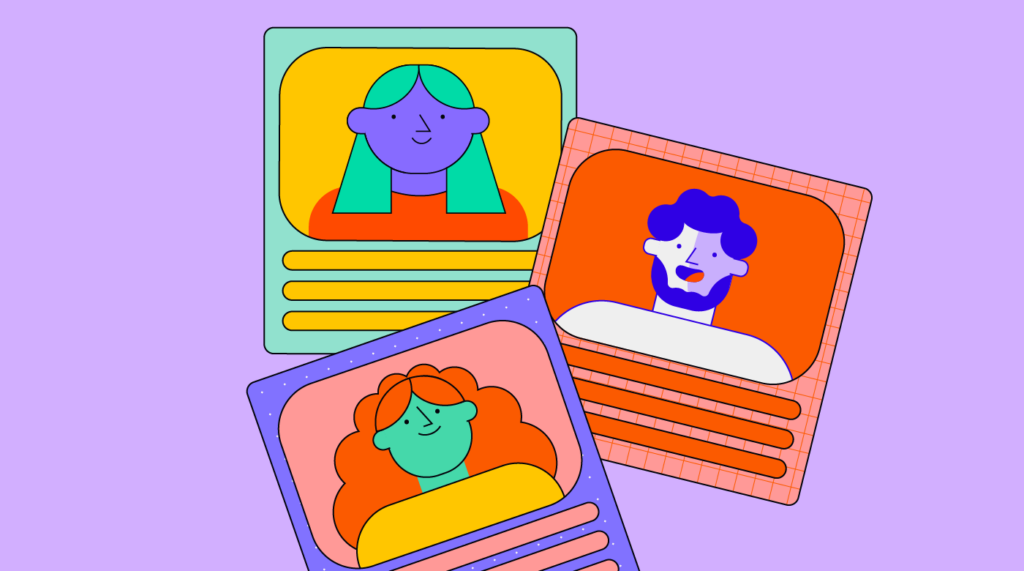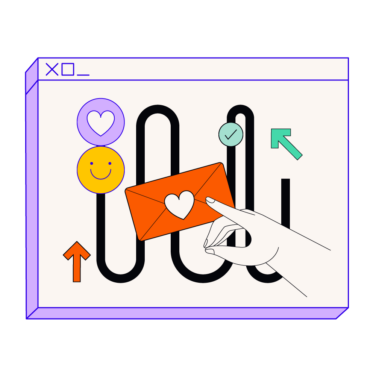According to HubSpot, using customer personas can make your website up to five times more effective and your emails up to 18 times more profitable. It’s also a way to provide a top customer experience. So, what are you waiting for?
Let’s be upfront; companies that don’t use buyer personas waste the majority of their time, efforts, and marketing budgets. We’re not in the business of wasting resources—quite the contrary, actually. So if you’re not certain what a customer persona is and how to use it to reach your target audience, you’re about to discover the secret sauce that fuels every big brand on Earth.
What is a customer persona?
You can call it a customer persona or a buyer persona—they’re two words for the same concept. In short, the persona is a representation of your ideal customer (if you’re B2C) or client (B2B). Buyer personas include:
- Demographic information about your target customers
- Their behaviors, motivations, needs, pain points, and challenges
Typically, all that information is gathered in one place in the form of an infographic, presentation, or spreadsheet. You can think of it as a representative sample or an archetype of your existing or desired customers.
Here’s what a customer persona might look like:
The vital question to ask at this point is, how are you getting to know this “person?” Obviously, some market research (primarily based on your current customer base) is necessary. Further along in this article, I’ll show you how to get all the data you need. What’s crucial, though, is that customer personas cannot be based on “hunches.”
Wellll, they can, but you won’t get very far this way. Personas based on guesswork tend to end up as two-dimensional stereotypes, which don’t actually represent real people. For your personas to be helpful, they have to be based on real, solid data that reflects your real, actual customers—data that should be collected from actual customer behavior and insights.
Your goal is to understand your customers better.
You want to know what their motivations are, what they value in your and other brands, what kind of communication they prefer, what everyday problems they want to solve, etc.
To obtain this kind of insight, you must try to walk in your customers’ shoes. And since we don’t always share our customers’ taste in shoes, we need to try different tactic for gathering information about their attributes, motivations, and pain points.
One place to start is a tactic called empathy mapping. Empathy maps are common in every UX department, and rightly so. They are simple frameworks split into four quadrants that are all about what your customers:
- Say
- Think
- Do
- Feel
With an empathy map, you can easily focus on real customer needs and feelings because you’re aiming to think the way they usually do. The key is to see things from your customers’ perspectives, and not from the perspectives you might have on certain customers.
Types of customer personas
We can distinguish four main types of user personas. All four types are useful when it comes to reaching potential customers with well-crafted messaging.
Primary persona
By far the most important type. The primary persona is the one that you want to reach and refer to most of the time. In practice, it represents your ideal (read: highest-paying) customers.
Secondary persona
This type is slightly less important concerning your marketing efforts, but you still can reach them effectively without harming the customer experience for people/companies represented by the primary persona.
Tertiary persona
These people are usually NOT your customers (you don't have them in your CRM tool, and your sales team doesn't reach out to them), but they are still involved in the process. Let's use an example. Suppose you want to sell subscriptions for a new tool for marketing teams. Your primary persona (ideal buyer) is a marketing manager or a CMO at a large company or agency. In this example, a tertiary persona can be a C-suite executive or a financial department with the final say on ordering a subscription for your platform.
Negative (exclusionary) persona
Here, you focus on people you don’t want as customers. These can be people with unrealistic expectations, people who frequently send ordered products back, or simply individuals/companies who aren’t a good fit for your products. One of the biggest mistakes brands make is to try to appeal to “everyone”—don’t do this. Negative personas help you avoid wasted time and resources on people who will never be valuable to your business.
Why should you use customer personas?
Simply put, because they help you reach the right customers, tailor the customer journey to the needs of your audience, and provide a top-notch customer experience. Let’s dig a bit deeper.
Reason 1: To attract the right audience
If you want to attract people interested in your products or services (and you do!), you have to know how to communicate with them, what reasoning and benefits to use, and what to avoid in the sales process. With customer personas, you can craft the right message for the right target market—a perfect recipe for effective marketing and excellent CX.
Moreover, this way, you can meet your potential customers' specific needs, behaviors, and concerns so that they feel understood and cared for.
Reason 2: To provide exceptional CX
Digital marketing is not only based on reaching new customers but also on retaining the current ones. Thanks to marketing personas, you can provide your audience with just the right UX, whether it’s concerning product development (with well-designed personas, you can develop better products and services that tick all your customers’ boxes), content marketing (blog posts and other content types can be extremely helpful concerning answering peoples’ questions and supporting them in the decision-making process), and customer support (your team must know how to communicate with your customers to anticipate and address their pain points).
In other words, customer personas help you not just acquire more customers but also keep them happy. And that’s the goal, isn’t it?
Reason 3: To save time and money
Targeting the wrong audience with your marketing messages is ineffective and, above all, costly. Every wrong person reached equals cash down the drain. You want to concentrate all of your sales and marketing efforts on people who are the most likely to become your customers. Producing thoughtfully-developed buyer personas helps you do just that.
Examples of customer personas
Some people think that personas are just for B2C companies. This is simply not true! There is always a real person on the other side of the table (or rather, the screen). But the truth is, there are some differences between personas for B2C and B2B. Let’s examine them closely by using two fictional examples.
Example 1: A B2C persona for a car rental
Background information (demographics and personality traits)
Name: Mark Explorer
Age: 30-40
Location: Seattle, Washington
Occupation: Senior Manager at an advertising agency
Motivations and aspirations
Mark loves to travel; he wants to visit every country in the world to gather great memories, take breathtaking pictures, and share his experiences with friends and loved ones.
Problems and challenges
Mark struggles with finding the best deals for his trips. Plus, he’s looking for services that will streamline his arrival and help him explore his destination. Although he’s making decent money, he doesn't like spending too much on his trips.
Behaviors
Before leaving his hometown, there is always a lot of planning involved. He has to know where to go, how to get there, and how to get around the city and the region. If possible, Mark always rents an economical and comfy car (AC is a must!).
With that done, the next step is to think about what to offer that might resonate with Mark and people like him. Things to consider might include a fleet with ample trunk space for luggage, free tourist guides for every customer, partnerships with hotels, blog posts about local attractions—seeing things from your customers’ perspective can illuminate infinite possibilities!
Example 2: A B2B persona for a marketing automation tool
Background information
Name: Sally Marketer
Age: 30-40
Location: Chicago, Illinois
Occupation: Marketing Manager in a large corporation
Motivations and aspirations
Sally has a lot of work to do every day. She wants to spend less time managing her company’s marketing activities.
Problems and challenges
Although Sally has an assistant, she feels like she’s still working too much. Repetitive actions (e.g., posting on the company’s social media accounts) take too much time. Because of that, she can’t concentrate on more important strategic goals.
Behaviors
Sally has an everyday to-do list that’s full of activities that could be streamlined or even automated altogether. She has to deal with them first before she has time to focus on more meaningful work.
Again, this is a perfect starting point to craft a message that responds to Sally’s needs and problems. You can highlight time-saving features in your website content, offer premium-tier services that take even more off Sally’s plate, and offer video tutorials that explain how to set up the most helpful features of your product.
Create your own customer persona
Congratulations, you’ve officially graduated from customer persona university! You can use this knowledge to create a template that comprises all the aforementioned elements. As a result, if you ever need to create new personas, you can base them on this simple formula.
A customer persona template should consist of:
- All the relevant sections (discussed above)
- Requirements taking your company’s specificity into account
- Guidelines on how to make a new persona
Or, just copy and paste this and fill it out:
Customer Persona Template
Background information
Name: [Name your persona]
Age: [How old are they?]
Location: [Where do they live?]
Occupation: [Are they a student? A professional? What’s their level of seniority?]
Motivations and aspirations
[What do they spend their day doing? What drives them to action?]
Problems and challenges
[What are their pain points in their personal life and/or work? Remember to consider both, whether for a B2C or B2B customer.]
Behaviors
[What are their habits? What does their day look like now, and how could it be improved?]
To learn more about persona creation, we also have an exhaustive guide to show exactly how to create personas that reflect the motivations of your actual customers.
Use personas to improve your CX strategy
Creating a customer persona is an ideal starting point for your entire CX strategy. The more your get to know your customers, the better-equipped you’ll be to deliver a world-class experience.
Enjoyed this article? Make sure to sign up for our newsletter—we’re relaunching it soon to bring you even more valuable content and help you level up your CX game.



